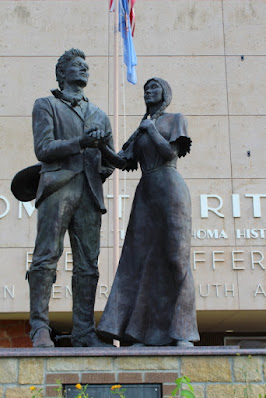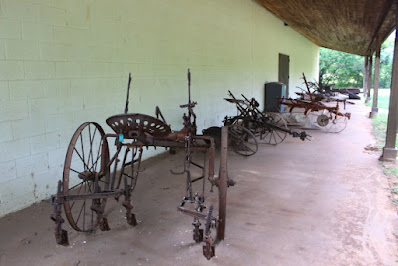There is a large cross that is hard to miss at the junction of I-35 and 2nd Street in Edmond, Oklahoma. The cross was built in 1998 on the MetroChurch Campus, stands 138.5 feet tall, and is made of 8-inch-thick prestressed-high-strength-concrete. MetroChuch is now part of LifeChurch.tv.
Located just to the west of the cross is the University of Central Oklahoma Campus where there is a large statue of the Minneconjou Teton Lakota Indian Chief Touch The Clouds. Touch The Clouds was the youngest son of Lone Horn and his brothers were Spotted Elk, Frog, and Hook Nose. He may also have been a cousin to Crazy Horse.
Touch the Clouds was known for his bravery, physical strength, skill in battle, and diplomacy in counsel. After the Battle of the Little Bighorn, Touch the Clouds took his tribe north to escape the cavalry, but eventually he surrendered at the Spotted Tail Agency in Nebraska. After his surrender, for the rest of his life he worked to get his people an education.
Guthrie (population 10,191) was the First Capital of Oklahoma Territory and Oklahoma when it became a State. Some of the original buildings located in the historic section of Guthrie are now being renovated and repurposed.
In 1889 the Guthrie National Bank was the first brick building constructed in Oklahoma Territory. It was also the first chartered national bank in the Territory. The first drugstore is now the Oklahoma Frontier Drugstore Museum and Apothecary Garden. Located just down the street is the Carnegie Library, which is now part of the adjacent Oklahoma Territorial Museum. In front of the museum is the Oklahoma Statehood Wedding Statue. The Statue symbolized "Miss Indian Territory" coming together with "Mr. Cowboy Oklahoma Territory" on November 16, 1907, to form the State of Oklahoma (46th State).
There are several museums around Oklahoma that feature the Cherokee Strip Land Run of 1893, and one of the museums is located just outside of Perry (population 5,128) The Perry museum is located on five acres of land and contains several buildings and outdoor exhibits that are all part of the museum complex.
At noon on September 16, 1893, the largest of the Oklahoma Land Runs started with 100,000 homesteaders racing to claim 42,000 homesteads. Immigrants from almost every place in the Unites States and many people from foreign countries participated in the land run.
Located just outside of Tonkawa is the Wilkins Oklahoma Truck Supply Company and a good example of what can happen when an inexperienced truck driver forgets the Golden Rule - "Always apply the trailer brakes first." Applying the truck's front brakes first can result in a disastrous situation.
Ponca City (population 25,387) is home of the Conoco Oil Museum that contains a history of the oil industry from wildcat days to current oil production technology. Oil enthusiast could spend a lot of time in this museum watching movies and playing with the hands-on equipment.
In the early 1900s E.W. Marland made a fortune in the oil business when he was living in Pennsylvania. but he lost everything in the Panic of 1907. Marland decided to move west and when he and his wife arrived in Ponca City, Oklahoma, in 1908, they owned nothing more than a few clothes.
Once again Marland entered the oil business and started his own company. Within a few years he had amassed a fortune of $100 million and controlled ten percent of the world's oil reserves. After his oil career, Marland went on to become Governor of Oklahoma.
In 1928 Marland constructed the E.F. Marland Mansion at a cost of $5.5 million. The Mansion is modeled after the Davanzati Palace in Florence, Italy, and contains 43,561 square-feet of living space in 55 rooms. Within the Mansion are twelve bathrooms, seven fireplaces, three kitchens, an elevator, Waterford crystal chandeliers, and a ballroom with a 24-karat gold leaf-covered ceiling that is now worth over $1.9 million. The Mansion is known as the "Palace on the Prairie" and guided tours are available on a scheduled basis.
Also located in Ponca City is the Pioneer Woman Museum & Statue that is dedicated to the pioneering women and their influence and contribution to development of the State and Nation. The 17-ft. tall bronze statue is called "Confident."
In 1926 twelve sculptors were asked to create a pioneer woman statue and upon completion, the twelve statues were toured around the country by train. At each train stop people were asked to vote on their favorite statue. Thousands of people voted on the statues and "Confident" was selected as the winner. In 1930 the statue was dedicated with over 40,000 people in attendance. Will Rogers was the Master of Ceremony at the dedication.
The 1893 Land Run Historical Center in Medford (population 996) is another one of the museums in Oklahoma dedicated to the events of 1893.
Through various treaties in the mid-1800s, the US Government gave the Cherokee Indians substantial lands in northwest Oklahoma that became known as Cherokee Territory.
During the Civil War, the Cherokee Indians decided to fight for the Confederacy; so after the War the government reduced the size of the Indian Territory as punishment for supporting the Confederacy. The Indians were paid $8.5 million for 6 million acres of land that the US Government reclaimed.
On September 16, 1893, the reclaimed Indian lands were opened to settlers in the largest land rush in Oklahoma history. The land run started at noon and an estimated 100,000 settlers filed claims for the 42,000 land parcels. On that day the cities of Enid, Perry, Alva, and Woodward were established on homesteaded lands.
The Great Salt Plains just west of Medford are similar to the area around the Great Salt Lake in Utah. While the Great Salt Lake in Utah is too salty to support fish, the Great Salt Plains Lake in Oklahoma is not as salty and the water supports fish and other wildlife. Water tests indicate that the saline content is about one-fourth that of the ocean. The Great Salt Plains National Wildlife Refuge surrounding thee Lake contains over 50-square miles and is under joint management between the US Fish & Wildlife Service and the Oklahoma Great Salt Plains State Park.
Selenite crystals are found just below the salt encrusted surface around the lake, but digging for crystals is only allowed in a designated area. During WW II the Army Air Corps used the area as a gunnery range and later Chemical Agent Identification Sets (CAIS) were dumped on the site. The military has cleared an area of munitions and CAISs that is now open to the public, but the public is not allowed outside of the delineated area. Unfortunately, I found myself on the wrong side of the lake and did not have time to drive to the other side of the Lake to hunt for selenite crystals.
After leaving the Lake, I encountered a really large golf ball and some unique roadside art.
 |
| GPS Coordinates: 36.740580 -98.127780 |
 |
| GPS Coordinates: 36.797392 -98.575447 |








































No comments:
Post a Comment